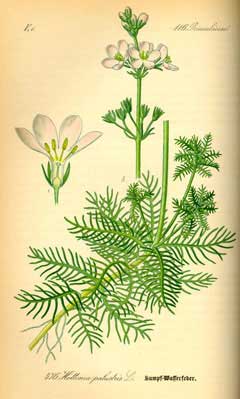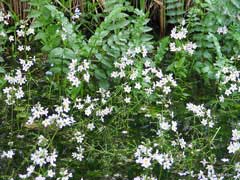 |
|
http://commons.wikimedia.org/wiki/File:Illustration_Hottonia_palustris0.jpg |
 |
| http://commons.wikimedia.org/wiki/User:Marco_Schmidt |
Translate this page:
Summary
Physical Characteristics

 Hottonia palustris is a PERENNIAL growing to 0.9 m (3ft) at a fast rate.
Hottonia palustris is a PERENNIAL growing to 0.9 m (3ft) at a fast rate.
See above for USDA hardiness. It is hardy to UK zone 6. It is in flower from May to June. The species is hermaphrodite (has both male and female organs) and is pollinated by Insects, Cleistogomy (self-pollinating without flowers ever opening). The plant is self-fertile.
Suitable for: light (sandy), medium (loamy) and heavy (clay) soils. Suitable pH: mildly acid, neutral and basic (mildly alkaline) soils. It cannot grow in the shade. It can grow in water.
UK Hardiness Map
US Hardiness Map
Synonyms
Plant Habitats
Pond;
Edible Uses
References More on Edible Uses
Medicinal Uses
Plants For A Future can not take any responsibility for any adverse effects from the use of plants. Always seek advice from a professional before using a plant medicinally.
Bach
The plant is used in Bach flower remedies - the keywords for prescribing it are 'Pride' and 'Aloofness'[209].
References More on Medicinal Uses
The Bookshop: Edible Plant Books
Our Latest books on Perennial Plants For Food Forests and Permaculture Gardens in paperback or digital formats.

Edible Tropical Plants
Food Forest Plants for Hotter Conditions: 250+ Plants For Tropical Food Forests & Permaculture Gardens.
More

Edible Temperate Plants
Plants for Your Food Forest: 500 Plants for Temperate Food Forests & Permaculture Gardens.
More

More Books
PFAF have eight books available in paperback and digital formats. Browse the shop for more information.
Shop Now
Other Uses
References More on Other Uses
Cultivation details
A vigorous water plant, either rooting in the mud a few centimetres below water level, or floating in the water[200]. Plants overwinter by means of winter resting buds which sink to the bottom of the pond until the following spring[200]. Plants are useful oxygenators of the water[200]. The flowers have a delicate mossy scent rather like the primrose or the fading perfume of the violet[245].
References Carbon Farming Information and Carbon Sequestration Information
Temperature Converter
Type a value in the Celsius field to convert the value to Fahrenheit:
Fahrenheit:
The PFAF Bookshop
Plants For A Future have a number of books available in paperback and digital form. Book titles include Edible Plants, Edible Perennials, Edible Trees,Edible Shrubs, Woodland Gardening, and Temperate Food Forest Plants. Our new book is Food Forest Plants For Hotter Conditions (Tropical and Sub-Tropical).
Shop Now
Plant Propagation
Seed - sow spring in pots of soil standing in water and only just cover the seed[200]. When they are large enough to handle, prick the seedlings out into individual pots and plant them out in the summer. Division or cuttings in the spring. Just throw them into the water or place them into the submerged marginal mud[200].
Other Names
If available other names are mentioned here
Native Range
TEMPERATE ASIA: Turkey EUROPE: Denmark, Austria, Belgium, Switzerland, Czech Republic, Germany, Hungary, Netherlands, Poland, Slovakia, Russian Federation (European part), Belarus, Lithuania, Latvia, Moldova, Ukraine, Croatia, Italy, Romania, Serbia, Slovenia, France
Weed Potential
Right plant wrong place. We are currently updating this section.
Please note that a plant may be invasive in one area but may not in your area so it's worth checking.
Conservation Status
IUCN Red List of Threatened Plants Status :

Growth: S = slow M = medium F = fast. Soil: L = light (sandy) M = medium H = heavy (clay). pH: A = acid N = neutral B = basic (alkaline). Shade: F = full shade S = semi-shade N = no shade. Moisture: D = dry M = Moist We = wet Wa = water.
Now available:
Food Forest Plants for Mediterranean Conditions
350+ Perennial Plants For Mediterranean and Drier Food Forests and Permaculture Gardens.
[Paperback and eBook]
This is the third in Plants For A Future's series of plant guides for food forests tailored to
specific climate zones. Following volumes on temperate and tropical ecosystems, this book focuses
on species suited to Mediterranean conditions—regions with hot, dry summers and cool, wet winters,
often facing the added challenge of climate change.
Read More
Expert comment
Author
L.
Botanical References
17200
Links / References
For a list of references used on this page please go here
Readers comment